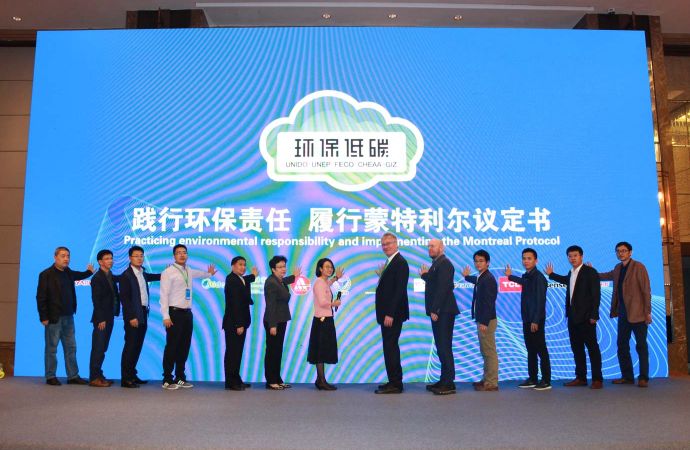The China Household Electrical Appliances Association provided an update on China’s R290 RAC industry.

Chinese air conditioner manufacturers join representatives from the Chinese government and UN Agencies on stage on 31 October 2018.
In 2018, eight major Chinese RAC manufacturers pledged to increase cumulative sales of split propane (R290) room air conditioners (RACs) in China to no fewer than 220,000 units by August 2019.
While the industry has faced unprecedented challenges over the past few years, notably the COVID-19 pandemic, the China Household Electrical Appliances Association (CHEAA) reports that the total cumulative number sold has now exceeded 270,000. A greater uptake of R290 AC units may now be possible following China's ratification this year of the Montreal Protocol's Kigali Amendment.
CHEAA is a non-governmental, not-for-profit industry association for home appliance manufacturers in China and undertakes government-led projects, such as the phase out of HCFCs and HFCs in the home appliance sector.
The following is a recent interview with Wang Lei, Secretary General of CHEAA, conducted by Hydrocarbons21.com to learn more about the current status of this industry’s development and the possible reasons why progress seems to be lagging.
Midea leads the way
Hydrocarbons21.com: Could you provide us with the latest figure for the total number of split-type RAC R290 units that have been sold and installed in China as of today?
Wang Lei: As far as we know, by the end of this November, the cumulative production and sales of split-type R290 RAC in China has exceeded 270,000 units.
Hydrocarbons21.com: Which companies contributed to this total?
Wang Lei: Manufacturers of the Chinese RAC industry, such as Midea, Haier, TCL and Aux, have contributed to the total R290 RAC sales, among which Midea has the largest proportion.
Hydrocarbons21.com: As of today, how many production lines have been converted to R290? What is the overall production capacity?
Wang Lei: Up to now, there have been 20 RAC production lines converted from R22 to R290, with an estimated production capacity of 5 million units.
Hydrocarbons21.com: What is the total number of split-type RAC R290 units that have been sold overseas to date?
Wang Lei: Chinese manufacturers need to acquire relevant certificates before they can sell split-type R290 RAC in the overseas market. According to our information, the “All Easy” series split-type R290 RAC of Midea has been available in the European market.
Up to now, we haven’t got the accurate statistics of split-type R290 sold in the overseas market, but Chinese manufacturers are trying to promote the commercialization of these split-type R290 units in the global market.
Increasing confidence in R290
Hydrocarbons21.com: Do you have any comment on the ratification of Kigali by China in June, or the updated GWP values for R290 (less than 1) in the latest IPCC report? How will these two developments affect the market uptake of R290 RAC in China?
Wang Lei: The Chinese government ratified the Kigali Amendment, and it came into effect on September 15. According to the amendment, China is required to freeze HFC consumption in 2024 and phase down beginning in 2029. At present, the Chinese government is developing and establishing relevant laws and regulations. R290, which can meet the requirements of the Kigali Amendment, is the alternative refrigerant technology chosen by the Chinese RAC industry. The ratification of the Kigali Amendment by the Chinese government has enhanced our confidence in this technology.
That the latest IPCC report has updated the GWP value for R290 to less than 1 shows that the scientific community is making progress in research and understanding of R290 technology. Meanwhile, it also makes clear that R290 possesses considerable potential in terms of reducing GHG emission and addressing climate change.
We believe these two issues will help the Chinese RAC industry and relevant stakeholders understand R290 technology more scientifically and strengthen the confidence of our industry and manufacturers about R290.
Hydrocarbons21.com: What is the next immediate challenge/focus for China’s R290 RAC sector?
Wang Lei: The main task for the Chinese RAC industry is to continue technology R&D and promote the commercialization of R290 RAC. We need to optimize the design and improve the performance of key components, with efforts to make R290 RAC meet the requirements of the updated energy-efficiency standards and improve its market competitiveness. [in this way] we may help the Chinese RAC industry reduce GHG emissions and correspond to the Chinese government’s carbon peaking and carbon neutrality goals through the adoption of environmentally friendly refrigerants and the promotion of energy efficiency.
Related stories



